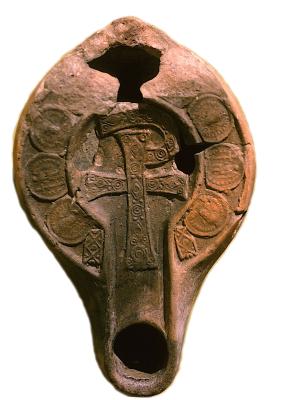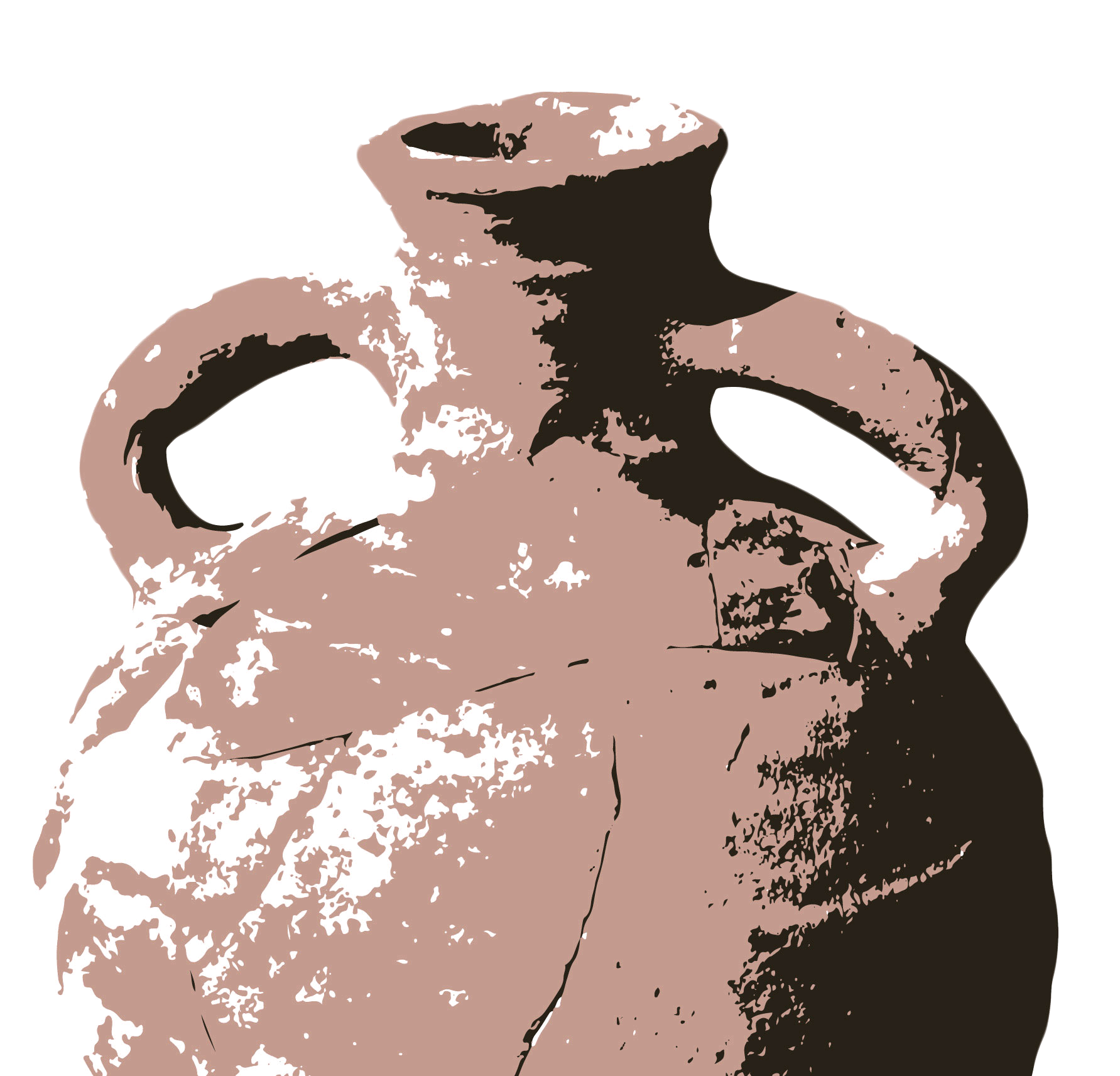
Campanaio and Castagna are two archaeological sites, 1 km apart, about 25 km west of Agrigento in Sicily. Both were first discovered in 1978 by Professor Roger Wilson during a field survey in the hinterland of the Greek city of Heraclea Minoa (which was occupied between the 6th and the 1st centuries BC). Both sites were partly excavated by teams under Professor Wilson's direction in a number of fieldwork seasons which took place first in 1980 and 1982–83 and then between 1994 and 1998 (the above image shows work in progress at Campanaio). The quality and quantity of ceramic finds were impressive. The finds were all drawn at the time, and much effort was spent on restoring well preserved vessels. Several leading Roman pottery specialists, including the late John Hayes and the late Roberta Tomber, worked on the material. Their studies, however, did not unfortunately reach final publication stage, although their detailed notes form part of the site archive and have been an immense aid to the present project. We aim to build on their research and contextualize the finds in the light of more recent developments in Roman ceramic studies and in the archaeology of the Sicilian countryside in Roman times.
Castagna
Castagna was an isolated farmhouse (with fifteen rooms, all with earth floors) of early imperial date (c. AD 50), with Hellenistic occupation below. It was twice altered and enlarged before its collapse c. 180/200. Despite its humble form, there were some high-status finds, including lead-glazed ware from Tarsus in Cilicia and a mould-blown glass beaker with a Greek inscription (“Rejoice! Enjoy yourself!”), also from the eastern Mediterranean. Animal bones were mostly sheep/goats, but also present were tortoise, hare, and deer (red, roe, and considerable quantities of fallow deer). A pit was dug in one of the ruined buildings in the fourth century.
Campanaio
Nestled on a gently sloping hill 5 km from the coast, the site of Campanaio covered an area of about three hectares and had an extraordinarily long life, from the Hellenistic period until the late Roman. Seven principal phases of activity have been identified. Phases I to III date from 200 to 1 BC: a complex of buildings (Area C) and a pottery workshop (Areas F-G) belong to this period. The latter is of particular interest as it documents two tile kilns, differing in shape and chronology, as well as two interconnecting cisterns with inflow and overflow pipelines, one consisting of Tunisian reused amphorae (c. 146 BC/100 BC). Phase IV dates to the early imperial period, but only scanty traces survived. Phase V documents a renewed occupation and building work in the late Roman times (c. AD 375-460). Different buildings date to this period: part of a warehouse (area B/D) whose tile fall sealed a considerable quantity of smashed amphorae; a second warehouse tacked onto the south side of the previous late Hellenistic building in area C; and a series of squared badly built buildings facing an open-air courtyard in Area E. A stone vat for separating olive oil from the water after pressing and some stone weight for a horizontal lever press date to the same period prove that Campanaio was also an oil production site. Dolia defossata alongside, mended in antiquity with lead, may also indicate wine production. Also, Area H produced a structure which started life as an amphora kiln, built in the second half of the 4th century, but was used as a lime kiln at the time of its abandonment c. AD 400, when it was used as a dump. A destruction occurred in the mid-5th cent., followed by a new occupation until the late 6th cent. (phase VI). Inhumation graves with Muslim burials (laid facing Mecca) indicate early medieval activity in area E (phase VII), but there is no evidence of contemporary material culture.

Preliminary report on Campanaio finds
A preliminary report in Papers of the British School at Rome (2000) includes a short report by John Hayes on the main pottery found at Campanaio. Considering the quantity and relative proportion of the main functional ceramic categories, Campanaio follows a typical coastal Mediterranean pattern and reflects the rural and domestic nature of the site. Local products, identified by their frequency and by comparison with the on-site kiln materials, show a dominant and characteristic fabric, constituting 60-70 per cent of the Roman Imperial finds. In the earlier layers, Sicilian (?) amphorae in other fabrics were associated with north African types belonging to the Punic tradition, some in the same fabric as those at Carthage finds of the Julio-Claudian period. Imports from the surroundings of Naples, characterized by their distinctive black sand fabric, were also common in 2nd and 1st cent. BC layers, alongside with other presumably Sicilian amphorae. Fine wares belong mainly to the usual imported categories from Campania (Campana A, 2nd/1st cent. BC) and possibly from the region of Syracuse (Campana C, late 2nd/1st cent. BC), mainland Italian fine wares (Italian sigillata, Augustan/1st cent. AD) including some of the earliest Arezzo products, and African red slip wares (2nd-6th cent. AD). Red- and black-slipped fine wares were fairly common in late Hellenistic contexts, but there is no clear evidence of a hypothetical Sicilian fine ware, locally produced. Some fragments of Megarian relief bowls indicate connections with Asia Minor. Finally, other particular ceramics are worth mentioning, notably a stamped African mortarium, a Rhodian wine amphora with stamped handle, a vessel appliqué with the head of a satyr, which is part of a brazier imported from Cyrenaica, and a Punic amphora with stamps (a caduceus flanked by neo-Punic letters). All this evidence proves that Campanaio was a consumption and, at the same time, a production site open to a considerable Mediterranean-wide trading pattern.
Bibliography
- Ducati, F. (2024). Simon Keay Award in Mediterranean Archaeology: Pottery in rural Roman Sicily: imported and locally produced wares at Campanaio (AG). Papers of the British School at Rome 92:362-363. doi:10.1017/S0068246224000308 open access link
- Wilson, R.J.A. and Leonard, Jr. (1980) Field Survey at Heraclea Minoa (Agrigento), Sicily. Journal of Field Archaeology 7: 219-239.
- Wilson, R.J.A. (1981) The hinterland of Heraclea Minoa (Sicily) in classical antiquity. In G. Barker and R. Hodges (eds), Archaeology and Italian Society. Prehistoric, Roman and Medieval Studies (British Archaeological Reports, International Series 102): 249-260. Oxford: British Archaeological Reports.
- Wilson, R.J.A. (1982) Una villa romana a Montallegro (Agrigento). Sicilia Archeologica 48: 7-20.
- Wilson, R.J.A. (1984-85) Eraclea Minoa. Gli scavi eseguiti nel territorio negli anni 1980-1983. Kokalos 30-31: 489-500 plus Tav. XLVI-XLIX.
- Wilson, R.J.A. (1985) Un insediamento agricolo romano a Castagna (Comune di Cattolica Eraclea, AG). Sicilia Archeologica 57-58: 11-35.
- Wilson, R.J.A. (1987-88) Archaeology in Sicily, 1982–87. Archaeological Reports 34:105–150.
- Wilson, R.J.A. (1990) Sicily under the Roman Empire. The archaeology of a Roman province, 63BC – AD535. Warminster, Aris and Phillips.
- Wilson, R.J.A. (1993) Nuovi scavi dall’insediamento agricolo ellenistico-romano di Castagna (AG), 1993. Quaderni dell’Università di Messina 8: 29-47 plus Tav. XVI-XX.
- Wilson, R.J.A. (1995) The Castagna and Campanaio Roman agricultural settlements project, central southern Sicily. Papers of the British School at Rome 63: 259–260.
- Wilson, R.J.A. (1995-96) Archaeology in Sicily 1988–1995. Archaeological Reports 42: 59–123.
- Wilson, R.J.A. (1996) Rural life in Roman Sicily: excavations at Castagna and Campanaio. In R.J.A. Wilson (ed.), From River Trent to Raqqa: Nottingham University archaeological fieldwork in Britain, Europe and the Middle East 1991–1995: 24-41. Nottingham, Department of Archaeology, University of Nottingham.
- Wilson, R.J.A. (1999) The Campanaio Roman agricultural project. Papers of the British School at Rome 67: 421–423
- Wilson, R.J.A. (2000a) Rural settlement in Hellenistic and Roman Sicily: Excavations at Campanaio (AG). Papers of the British School at Rome 68: 337-369. http://www.jstor.org/stable/40311034?origin=JSTOR-pdf
- Wilson, R.J.A. (2000b) Campanaio – an agricultural settlement in Roman Sicily. Antiquity 74: 289-290
- Wilson, R.J.A. (2000c) Ciceronian Sicily: an archaeological perspective. In C. Smith and J. Serrati (eds.), Sicily from Aeneas to Augustus: new approaches in archaeology and history: 134–160. Edinburgh: Edinburgh University Press.
- Wilson, R.J.A., (2000d) Aqueducts and water supply in Greek and Roman Sicily: the present status quaestionis. In G.C.M. Jansen (ed.), Cura Aquarum in Sicilia. Proceedings of the Tenth International Congress on the History of Water Management and Hydraulic Engineering in the Mediterranean Region, Syracuse, May 16–22, 1998 (Bulletin Antieke Beschaving Supplement 5): 5–36. Leiden, Stichtung BABesch.
- Wilson, R.J.A. (2001), Vita rurale nella Sicilia ellenistico-romana: l’insediamento di Campanaio’, Kalos 13.4, pp. 24–31.
We are grateful to Soprintendenza BB.CC.AA. di Agrigento for granting permissions to conduct new research on Campanaio and Castagna
